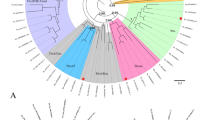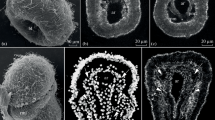Abstract
We investigated the inductive signals originating from the vegetal blastomeres of embryos of the sand dollar Peronella japonica, which is the only direct developing echinoid species that forms micromeres. To investigate the inductive signals, three different kinds of experimental embryos were produced: micromere-less embryos, in which all micromeres were removed at the 16-cell stage; chimeric embryos produced by an animal cap (eight mesomeres) recombined with a micromere quartet isolated from a 16-cell stage embryo; and chimeric embryos produced by an animal cap recombined with a macromere-derived layer, the veg1 or veg2 layer, isolated from a 64-cell stage embryo. Novel findings obtained from this study of the development of these embryos are as follows. Micromeres lack signals for endomesoderm specification, but are the origin of a signal establishing the oral–aboral (O–Ab) axis. Some non-micromere blastomeres, as well as micromeres, have the potential to form larval skeletons. Macromere descendants have endomesoderm-inducing potential. Based on these results, we propose the following scenario for the first step in the evolution of direct development in echinoids: micromeres lost the ability to send a signal endomesoderm induction so that the archenteron was formed autonomously by macromere descendants. The micromeres retained the ability to form larval spicules and to establish the O–Ab axis.






Similar content being viewed by others
References
Amemiya S (1996) Complete regulation of development throughout metamorphosis of sea urchin embryos devoid of macromeres. Dev Growth Differ 38:465–476
Amemiya S, Arakawa E (1996) Variation of cleavage pattern permitting normal development in a sand dollar, Peronella japonica: comparison with other sand dollar. Dev Genes Evol 206:125–135
Amemiya S, Emlet RB (1992) The development and larval form of an echinothurioid echinoid, Asthenosoma ijimai, revisited. Biol Bull 182:15–30
Emlet RB (1995) Larval spicules, cilia, and symmetry as remnants of indirect development in the direct developing sea urchin Heliocidaris erythrogramma. Dev Biol 167:405–415
Ettensohn CA, Sweet HC (2000) Patterning the early sea urchin embryo. Curr Top Dev Biol 50:1–44
Hamada M, Kiyomoto M (2003) Signals from primary mesenchyme cells regulate endoderm differentiation in the sea urchin embryo. Dev Growth Differ 45:339–350
Henry JJ, Raff RA (1990) Evolutionary change in the process of dorsoventral axis determination in the direct developing sea urchin, Heliocidaris erythrogramma. Dev Biol 141:55–69
Henry JJ, Raff RA (1994) Progressive determination of cell fates along the dorsoventral axis in the sea urchin Heliocidaris erythrogramma. Roux's Arch Dev Biol 204:62–69
Henry JJ, Wray GA, Raff RA (1990) The dorsoventral axis is specified prior to first cleavage in the direct developing sea urchin Heliocidaris erythrogramma. Development 110:875–884
Horstadius S (1973) Experimental embryology of echinoderms. Clarendon, Oxford
Iijima M, Amemiya S (2002) Potential of veg2 blastomeres to induce endoderm differentiation in sea urchin embryos. Zool Sci 19:81–85
Ishizuka Y, Minokawa T, Amemiya S (2001) Micromere descendants at the blastula stage are involved in normal archenteron formation in sea urchin embryos. Dev Genes Evol 211:83–88
Kauffman JS, Raff RA (2003) Patterning mechanisms in the evolution of derived developmental life histories: the role of Wnt signaling in axis formation of the direct-developing sea urchin Heliocidaris erythrogramma. Dev Genes Evol 213:612–624
Kitazawa C, Amemiya S (1997) Evagination of the amniotic cavity in larvae derived from lithium-treated embryos of a direct developing echinoid, Peronella japonica. J Exp Zool 279:309–312
Logan CY, McClay DR (1999) Lineages that give rise to endoderm and mesoderm in the sea urchin embryo. In: Moody SA (ed) Cell lineage and fate determination. Academic, London, pp 41–57
Minokawa T, Amemiya S (1998) Mesodermal cell differentiation in echinoid embryos derived from the animal cap recombined with a quartet of micromeres. Zool Sci 15:541–545
Minokawa T, Amemiya S (1999) Timing of the potential of micromere-descendants in echinoid embryos to induce endoderm differentiation of mesomere-descendants. Dev Growth Differ 41:535–547
Morris VB (1995) Apluteal development of the sea urchin Holopneustes purpurescens Agassiz (Echinodermata: Echinoidea: Euechinoidea). Zool J Linnean Soc 114:349–364
Mortensen T (1921) Studies of the development and larval forms of echinoderms. G. E. C. Gad, Copenhagen
Nakata H, Minokawa T (2009) Expression patterns of wnt8 orthologs in two sand dollar species with different developmental modes. Gene Expr Patterns 9:152–157
Okazaki K (1975) Normal development to metamorphosis. In: Czihak G (ed) The sea urchin embryo. Springer, Berlin, pp 177–232
Okazaki K, Dan K (1954) The metamorphosis of partial larvae of Peronell japonica Mortensen, a sand dollar. Biol Bull 106:83–99
Olson RR, Cameron JL, Young CM (1993) Larval development (with observations on spawning) of the pencil urchin Phyllacanthus imperialis: a new intermediate larval form? Biol Bull 185:77–85
Parks AL, Bisgrove BW, Wray GA, Raff RA (1989) Direct development in the sea urchin Phyllacanthus parvispinus (Cidaroidea): phylogenetic history and functional modification. Biol Bull 177:96–109
Raff RA (1987) Constraint, flexibility, and phylogenetic history in the evolution of direct development in sea urchins. Dev Biol 119:6–19
Ransick A, Davidson EH (1995) Micromeres are required for normal vegetal plate specification in sea urchin embryos. Development 121:3215–3222
Showman RM, Foerder CA (1979) Removal of the fertilization membrane of sea urchin embryos employing aminotriazole. Exp Cell Res 120:253–255
Strathmann RR (1978) The evolution and loss of feeding larval stages of marine invertebrates. Evolution 32:894–906
Sweet HC, Hodor PG, Ettensohn CA (1999) The role of micromere signaling in Notch activation and mesoderm specification during sea urchin embryogenesis. Development 126:5255–5265
Sweet HC, Gehring M, Ettensohn CA (2002) LvDelta is a mesoderm-inducing signal in the sea urchin embryo and can endow blastomeres with organizer-like properties. Development 129:1945–1955
Whittaker JR, Meedel TH (1989) Two histospecific enzyme expressions in the same cleavage-arrested one-celled ascidian embryos. J Exp Zool 250:168–175
Willams DHC, Anderson DT (1975) The reproductive system, embryonic development, larval development and metamorphosis of the sea urchin Heliocidaris erythrogramma (val.) (Echinoidea: Echinometridae). Aust J Zool 23:371–403
Wray GA, Raff RA (1989) Evolutionary modification of cell lineage in the direct-developing sea urchin Heliocidaris erythrogramma. Dev Biol 132:458–470
Wray GA, Raff RA (1990) Novel origins of lineage founder cells in the direct-developing sea urchin Heliocidaris erythrogramma. Dev Biol 141:41–54
Yajima M (2007) Evolutionary modification of mesenchyme cells in sand dollars in the transition from indirect to direct development. Evol Dev 9:257–266
Acknowledgments
We thank the members of the Misaki Marine Biological Station of the University of Tokyo and the Noto Marine Laboratory of Kanazawa University for supplying the animals. Many thanks are due to Dr. Masaaki Yamaguchi and all of the members of his laboratory for invaluable discussion and their help in animal collection. This study was partially supported by a “Grant-in-Aid for Young Scientists” (18770191) from the Ministry of Education, Culture, Sports, Science, and Technology of Japan, a Narishige Zoological Science Award, and a research grant from the graduate school of life sciences, Tohoku University, to T.M.
Author information
Authors and Affiliations
Corresponding author
Additional information
Communicated by: H. Nishida
Rights and permissions
About this article
Cite this article
Iijima, M., Ishizuka, Y., Nakajima, Y. et al. Evolutionary modification of specification for the endomesoderm in the direct developing echinoid Peronella japonica: loss of the endomesoderm-inducing signal originating from micromeres. Dev Genes Evol 219, 235–247 (2009). https://doi.org/10.1007/s00427-009-0286-8
Received:
Accepted:
Published:
Issue Date:
DOI: https://doi.org/10.1007/s00427-009-0286-8




